

Max Born. Wilhelm Wien. He also formulated an expression for the black-body radiation which is correct in the photon-gas limit.
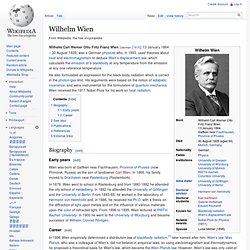
His arguments were based on the notion of adiabatic invariance, and were instrumental for the formulation of quantum mechanics. Wien received the 1911 Nobel Prize for his work on heat radiation. Eugene Wigner. Arnold Sommerfeld. Erwin Schrödinger. Max Planck. Max Karl Ernst Ludwig Planck, FRS[1] (April 23, 1858 – October 4, 1947) was a German theoretical physicist who originated quantum theory, which won him the Nobel Prize in Physics in 1918.[2] Planck made many contributions to theoretical physics, but his fame rests primarily on his role as originator of the quantum theory.

This theory revolutionized human understanding of atomic and subatomic processes, just as Albert Einstein’s theory of relativity revolutionized the understanding of space and time. Together they constitute the fundamental theories of 20th-century physics. Early life and career[edit] Planck came from a traditional, intellectual family. Wolfgang Pauli. John von Neumann. John von Neumann (/vɒn ˈnɔɪmən/; December 28, 1903 – February 8, 1957) was a Hungarian and later American pure and applied mathematician, physicist, inventor, polymath, and polyglot.
Hans Kramers. Hendrik Anthony "Hans" Kramers (2 February 1894 – 24 April 1952) was a Dutch physicist who worked with Niels Bohr to understand how electromagnetic waves interact with matter.
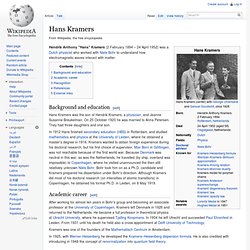
Background and education[edit] Hans Kramers was the son of Hendrik Kramers, a physician, and Jeanne Susanne Breukelman. On 25 October 1920 he was married to Anna Petersen. They had three daughters and one son. Pascual Jordan. Ernst Pascual Jordan (18 October 1902 – 31 July 1980) was a theoretical and mathematical physicist who made significant contributions to quantum mechanics and quantum field theory.
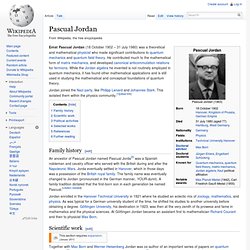
He contributed much to the mathematical form of matrix mechanics, and developed canonical anticommutation relations for fermions. While the Jordan algebra he invented is not routinely employed in quantum mechanics, it has found other mathematical applications and is still used in studying the mathematical and conceptual foundations of quantum theory. Jordan joined the Nazi party, like Philipp Lenard and Johannes Stark.
This isolated them within the physics community.[1][dead link] Family history[edit] An ancestor of Pascual Jordan named Pascual Jorda[2] was a Spanish nobleman and cavalry officer who served with the British during and after the Napoleonic Wars. Werner Heisenberg. Richard Feynman. Hugh Everett III. Paul Ehrenfest. Paul Ehrenfest (January 18, 1880 – September 25, 1933) was an Austrian and Dutch theoretical physicist, who made major contributions to the field of statistical mechanics and its relations with quantum mechanics, including the theory of phase transition and the Ehrenfest theorem.
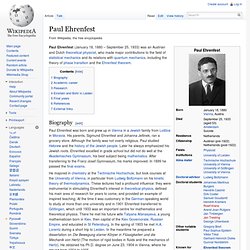
Biography[edit] He majored in chemistry at the Technische Hochschule, but took courses at the University of Vienna, in particular from Ludwig Boltzmann on his kinetic theory of thermodynamics. These lectures had a profound influence: they were instrumental in stimulating Ehrenfest's interest in theoretical physics, defined his main area of research for years to come, and provided an example of inspired teaching. At the time it was customary in the German-speaking world to study at more than one university and in 1901 Ehrenfest transferred to Göttingen, which until 1933 was an important centre for mathematics and theoretical physics.
The Ehrenfests returned to Göttingen in September 1906. Paul Dirac. Paul Adrien Maurice Dirac OM FRS[2] (/dɪˈræk/ di-RAK; 8 August 1902 – 20 October 1984) was an English theoretical physicist who made fundamental contributions to the early development of both quantum mechanics and quantum electrodynamics.
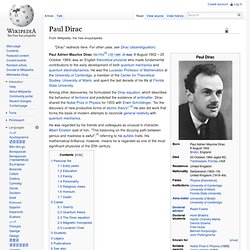
He was the Lucasian Professor of Mathematics at the University of Cambridge, a member of the Center for Theoretical Studies, University of Miami, and spent the last decade of his life at Florida State University. Among other discoveries, he formulated the Dirac equation, which describes the behaviour of fermions and predicted the existence of antimatter. Dirac shared the Nobel Prize in Physics for 1933 with Erwin Schrödinger, "for the discovery of new productive forms of atomic theory".[3] He also did work that forms the basis of modern attempts to reconcile general relativity with quantum mechanics.
He was regarded by his friends and colleagues as unusual in character. Personal life Early years. Louis de Broglie. Louis-Victor-Pierre-Raymond, 7th duc de Broglie, (/dəˈbrɔɪ/; French pronunciation: [dəbʁɔj],[1][2] [dəbʁœj] ( ); 15 August 1892 – 19 March 1987) was a French physicist who made groundbreaking contributions to quantum theory.

In his 1924 PhD thesis he postulated the wave nature of electrons and suggested that all matter has wave properties. This concept is known as wave-particle duality or the de Broglie hypothesis. He won the Nobel Prize for Physics in 1929. Satyendra Nath Bose. Niels Bohr. Niels Henrik David Bohr (Danish: [ˈnels ˈboɐ̯ˀ]; 7 October 1885 – 18 November 1962) was a Danish physicist who made foundational contributions to understanding atomic structure and quantum theory, for which he received the Nobel Prize in Physics in 1922.
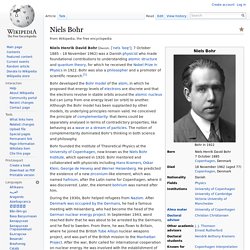
Bohr was also a philosopher and a promoter of scientific research.[1] Bohr founded the Institute of Theoretical Physics at the University of Copenhagen, now known as the Niels Bohr Institute, which opened in 1920. Bohr mentored and collaborated with physicists including Hans Kramers, Oskar Klein, George de Hevesy and Werner Heisenberg. He predicted the existence of a new zirconium-like element, which was named hafnium, after the Latin name for Copenhagen, where it was discovered. Later, the element bohrium was named after him. During the 1930s, Bohr helped refugees from Nazism. Early years[edit]
David Bohm. John Stewart Bell.